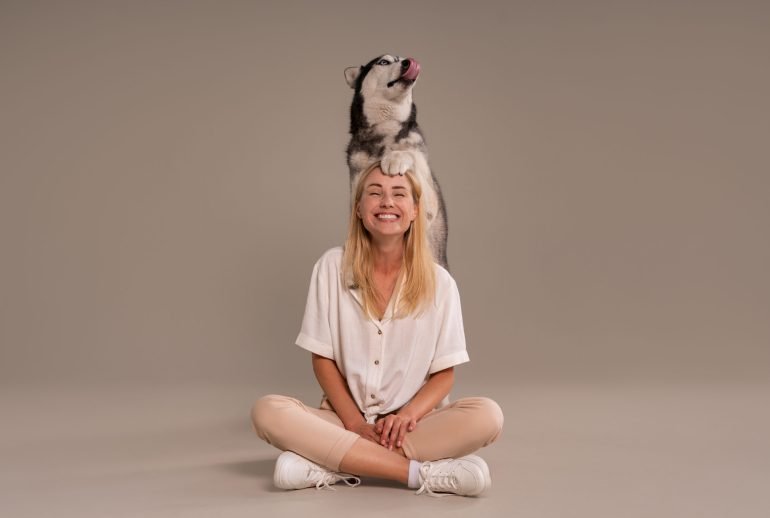Bringing a female dog into your home is an incredible experience. Whether you call her a “bitch” (the technically correct term), a dam (if she’s a mother), or just your best girl, her unique physiology comes with a specific set of needs, health considerations, and behaviors.
Unlike male dogs, a female dog’s life is shaped by her reproductive cycle. Understanding this cycle—commonly known as “going into heat”—is one of the most critical parts of responsible ownership, even if you plan on spaying her.
This comprehensive guide will cover every aspect of female dog health. We’ll explore the pros and cons of spaying, break down the heat cycle stage by stage, discuss common health risks, and provide you with the knowledge you need to give your girl the happiest, healthiest life possible.
Part 1: The Big Decision: To Spay or Not to Spay?
This is often the first major health decision you’ll make for your female dog. Spaying (the common term for an ovariohysterectomy or ovariectomy) is the surgical removal of a female dog’s reproductive organs (ovaries and usually the uterus).
While keeping a dog “intact” (unspayed) is a necessity for reputable breeders, the vast majority of veterinarians in the United States recommend spaying for pet dogs. Here’s why.
The Benefits of Spaying Your Female Dog
- Prevents Pyometra (A Life-Threatening Emergency): This is the #1 medical reason to spay. Pyometra is a severe bacterial infection of the uterus. As an intact female dog ages, her repeated heat cycles cause hormonal changes that make this infection more likely. A pyometra is a critical emergency that requires expensive and risky surgery. Spaying eliminates this risk entirely.
- Drastically Reduces the Risk of Mammary Cancer: Mammary tumors (breast cancer) are malignant in about 50% of cases in dogs. According to the American College of Veterinary Surgeons (External Link), spaying a female dog before her first heat cycle reduces her risk of developing these tumors to less than 1%. The risk climbs with every cycle she goes through.
- Eliminates the Heat Cycle: This is a major quality-of-life benefit. You won’t have to deal with:
- The bloody discharge (which can stain furniture and carpets).
- The need to keep her in “diapers.”
- The constant, unwanted attention from male dogs.
- The stress and risk of her escaping to find a mate.
- Prevents Unwanted Pregnancies: This is the most obvious benefit. Millions of dogs are euthanized in shelters across the U.S. every year. Spaying is the only 100% effective way to ensure your female dog doesn’t contribute to pet overpopulation.
Potential Considerations and Timing
The conversation around when to spay has evolved.
- Traditional View: Spay at 6 months of age, before the first heat. This provides the maximum medical benefits regarding cancer prevention.
- Modern View (Especially for Large Breeds): Some studies have suggested that in large and giant breed dogs (like Golden Retrievers, Labradors, and German Shepherds), spaying after they are fully grown (12-24 months) may help reduce the risk of certain orthopedic issues, like cruciate ligament tears.
The Verdict: This is a crucial conversation to have with your veterinarian. They can weigh the pros and cons based on your dog’s specific breed, size, and lifestyle.
Part 2: Understanding the Female Dog Heat Cycle (Estrus Cycle)
If you choose not to spay, or if you’ve adopted an intact female dog, understanding her heat cycle is non-negotiable.
When Does a Dog’s First Heat Occur?
It varies dramatically by breed.
- Small Breeds: Can have their first heat as young as 6 months.
- Large & Giant Breeds: May not have their first heat until they are 18-24 months old.
How Often Do Dogs Go Into Heat?
Most female dogs go into heat every 6 to 8 months. Unlike humans, dogs do not go through menopause; they will continue to have heat cycles for their entire lives, though the cycles may become less regular as they age.
The heat cycle is broken down into four distinct stages.
[Simple infographic showing the 4 stages of the heat cycle in a circle.]
The 4 Stages of the Estrus Cycle
1. Proestrus (The “Getting Ready” Stage)
- Duration: Averages 9 days (but can range from 3-17 days).
- What You’ll See: This is when you first notice symptoms.
- The vulva will become swollen and enlarged.
- You’ll see a bloody discharge.
- Your female dog may become more clingy, anxious, or irritable.
- Crucially: She will attract male dogs but will not be receptive to them. She’ll likely tuck her tail or sit down if one approaches.
2. Estrus (The “Mating” Stage)
- Duration: Averages 9 days (but can range from 3-21 days).
- What You’ll See: This is the only time your female dog is fertile and can get pregnant.
- The discharge often lightens in color, becoming watery or pinkish-tan.
- The vulva remains swollen.
- The “Flagging” Behavior: This is the hallmark sign. She will now accept a male’s advances. If you scratch her back near the base of her tail, she will lift her tail and move it to the side.
- THIS IS THE DANGER ZONE. She will be actively seeking a mate and can become a master escape artist. She must be supervised 100% of the time, even in a fenced yard.
3. Diestrus (The “After” Stage)
- Duration: About 60-90 days.
- What You’ll See: The heat cycle is officially over.
- Her vulva returns to its normal size.
- The discharge stops.
- She is no longer interested in males.
- What’s Happening Inside: Her body will act as if it’s pregnant, whether she is or not. Her progesterone levels will be high. This is the stage where a “false pregnancy” (pseudopregnancy) can occur.
4. Anestrus (The “Resting” Stage)
- Duration: About 3-5 months.
- What You’ll See: This is the dormant, resting period before the next cycle begins. Your dog will show no hormonal signs or behaviors.
Part 3: Managing a Female Dog in Heat
If you have an intact female dog, her heat cycle requires careful management to prevent pregnancy and keep her safe.
- Never Leave Her Unattended: Not for a second. Male dogs can smell a female in heat from miles away. They can (and will) jump fences, dig under them, or wait by your door.
- Leash Walks Only: This is not the time for the dog park or off-leash romps. Keep walks short and purposeful.
- Use Doggy Diapers: This is a management tool, not a prevention tool. It will help keep your house clean from the discharge but will not prevent a determined male dog from mating with her.
- Be Aware of Her Scent: The discharge carries her scent. If she’s in the backyard, you may want to rinse the area with water to dilute the scent that’s attracting males.
- Keep Her Calm: She may be anxious or irritable. Provide a quiet, safe space for her with her favorite toys and bedding.
Part 4: Specific Female Dog Health Concerns
Beyond the heat cycle, female dogs (both spayed and intact) have specific health risks to be aware of.

1. Pyometra (Intact Dogs)
As mentioned, this is a severe uterine infection. It typically occurs in middle-aged or older intact dogs in the “Diestrus” phase (4-8 weeks after a heat cycle).
- Symptoms: Lethargy, depression, loss of appetite, increased drinking and urination, vomiting. You may or may not see a pus-like discharge from the vulva.
- Action: This is a deadly emergency. If you see these symptoms in your intact female dog, go to an emergency vet immediately.
2. Mammary Tumors (Intact Dogs)
These are the most common tumors in intact female dogs.
- Symptoms: Feel for any lumps or bumps along her belly (mammary chains) during belly rubs.
- Action: See your vet. Early detection and surgical removal are key. This risk is why spaying is so heavily recommended.
3. False Pregnancy (Pseudopregnancy)
This is a very common and bizarre phenomenon that occurs in intact dogs during the Diestrus phase. The dog’s body and mind genuinely believe she is pregnant.
- Symptoms: She may start “nesting” (shredding blankets), lactating (producing milk), and mothering objects like a stuffed toy. She can also be anxious or protective of her “puppies.”
- Action: It usually resolves on its own in a few weeks, but if the behaviors are severe or she’s producing a lot of milk, see your vet. Do not milk her, as this can stimulate more production.
4. Urinary Tract Infections (UTIs)
All dogs can get UTIs, but the anatomy of the female dog (a shorter urethra) can make them more susceptible.
- Symptoms: Frequent urination, straining to urinate, having “accidents” in the house, bloody or cloudy urine, or licking her private area excessively.
- Action: See your vet. UTIs are easily treated with antibiotics but can lead to kidney infections if ignored.
5. Spay Incontinence (Spayed Dogs)
This is a common, manageable side effect that can develop in a small percentage of spayed dogs, often years after the surgery. It’s caused by a weakening of the bladder sphincter due to the lack of estrogen.
- Symptoms: Leaking or dribbling urine, most often while she is asleep or resting. She won’t even know she’s doing it.
- Action: Don’t scold her! See your vet. This condition is typically very easy to manage with a safe, daily medication (like Proin) that strengthens the bladder sphincter.
Conclusion: Being a Great Advocate for Your Girl
Owning a female dog is a journey with unique challenges and rewards. Her health is directly tied to her reproductive status.
The single most important decision you will make for her long-term health is whether or not to spay, a decision best made after a thorough discussion with your veterinarian.
If you choose to keep her intact, you are taking on the responsibility of managing her heat cycles, protecting her from unwanted pregnancies, and vigilantly monitoring her for life-threatening conditions like pyometra and mammary cancer.
By understanding her body and her needs, you can be her best advocate and ensure she lives a long, vibrant, and healthy life by your side.
For more on canine health, the American Veterinary Medical Association (AVMA) (External Link) provides excellent, trusted resources for pet owners.


